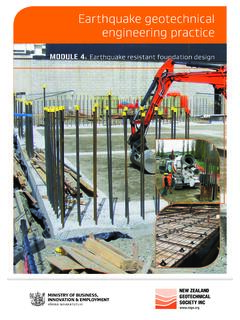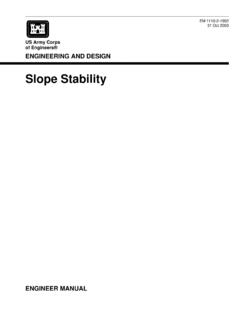Transcription of Design of footings - Decoding Eurocode 7
1 Chapter 10 Design of footingsThe Design of footings is covered by Section 6 of Eurocode 7 Part 1, Spreadfoundations , whose contents are as follows: (2 paragraphs) states (1) and Design situations (3) and construction considerations (6) limit state Design (32) limit state Design (30) on rock; additional Design considerations (3) Design of foundations (6) of the subsoil (2)Section 6 of EN 1997-1 applies to pad, strip, and raft foundations and someprovisions may be applied to deep foundations, such as caissons.[EN 1997-1 (1)P and (2)] investigation for footingsAnnex of Eurocode 7 Part 2 provides outline guidance on the depth ofinvestigation points for spread foundations, as illustrated in Figure 133. (SeeChapter 4 for guidance on the spacing of investigation points.)
2 The recommended minimum depth of investigation, za, for spreadfoundations supporting high-rise structures and civil engineering projects isthe greater of:3 and 6aFazb zm where bF is thefoundation s breadth. Forraft foundations: bB is the breadth ofthe depth za may bereduced to 2m if theFigure 133. Recommended depth of investigationfor spread foundations312 Decoding Eurocode 7 weaker strata are unlikely to occur at depth, structural weaknesses suchas faults are absent, and solution features and other voids are not expectedfoundation is built on competent strata with distinct ( known) indistinct geology, at least one borehole should go to at least 5m. Ifbedrock is encountered, it becomes the reference level for za.
3 [EN 1997-2 (4)]Greater depths of investigation may be needed for very large or highlycomplex projects or where unfavourable geological conditions areencountered.[EN 1997-2 (2)NOTE and (3)] situations and limit statesFigure 134 shows some of the ultimate limit states that spread foundationsmust be designed to withstand. From left to right, these include: (top) loss ofstability owing to an applied moment, bearing failure, and sliding owing toan applied horizontal action; and (bottom) structural failure of thefoundation base and combined failure in the structure and the 134. Examples of ultimate limit states for footingsDesign of footings313 Eurocode 7 lists a number of things that must be considered when choosingthe depth of a spread foundation, some of which are illustrated in Figure 135.
4 [EN 1997-1 (1)P] of designEurocode 7 requires spread foundations to be designed using one of thefollowing methods:[EN 1997-1 (5)P]MethodDescriptionConstraintsDirectC arry out separate analysesfor each limit state, bothultimate (ULS) andserviceability (SLS)(ULS) Model envisagedfailure mechanism(SLS) Use a serviceabilitycalculationIndirectUse comparable experiencewith results of field &laboratory measurements &observationsChoose SLS loads tosatisfy requirements ofall limit statesPrescriptiveUse conventional &conservative Design rulesand specify control ofconstructionUse presumed bearingresistanceFigure 135. Design considerations for footings314 Decoding Eurocode 7 which also appear in BS 8004 The indirect method is used predominantly for geotechnical Category 1structures, where there is good local experience, ground conditions are wellknown and uncomplicated, and the risks associated with potential failure orexcessive deformation of the structure are low.
5 Indirect methods may also beapplied to higher risk structures where it is difficult to predict the structuralbehaviour with sufficient accuracy from analytical solutions. In these cases,reliance is placed on the observational method and identification of a rangepotential behaviour. Depending on the observed behaviour, the final designof the foundation can be decided. This approach ensures that theserviceability condition is met but does not explicitly provide sufficientreserve against ultimate conditions. It is therefore important that the limitingdesign criteria for serviceability are suitably prescriptive method may be used for geotechnical Category 1 structures,where ground conditions are well known. Unlike British standard BS 8004 which gives allowable bearing pressures for rocks, non-cohesive soils,cohesive soils, peat and organic soils, made ground, fill, high porosity chalk,and Keuper Marl (now called the Mercia Mudstone)1 Eurocode 7 onlyprovides values of presumed bearing resistance for rock (via a series ofcharts in Annex G).
6 The direct method is discussed in some detail in the remainder of this book does not attempt to provide complete guidance on the Design ofspread foundations, for which the reader should refer to any well-establishedtext on the subject to vertical actionsFor a spread foundation subject to vertical actions, Eurocode 7 requires thedesign vertical action Vd acting on the foundation to be less than or equal tothe Design bearing resistance Rd of the ground beneath it:[EN 1997-1 exp ( )]ddVR Vd should include the self-weight of the foundation and any backfill on equation is merely a re-statement of the inequality:ddER discussed at length in Chapter 6. Rather than work in terms of forces,engineers more commonly consider pressures and stresses, so we willrewrite this equation as: Design of footings315 EdRdqq where qEd is the Design bearing pressure on the ground (an action effect), andqRd is the corresponding Design 136 shows afooting carryingcharacteristic verticalactions VGk(permanent) and VQk(variable) imposedon it by thesuper-structure.
7 Thecharacteristic self-weights of thefooting and of thebackfill upon it areboth permanentactions (WGk). Thefollowing sub-sections explain how qEd and qRd are obtained from VGk, VQk,WGk, and ground of actionsThe characteristic bearing pressure qEk shown in Figure 136 is given by:,()GkiQk iGkrepiEkVVWVqAA ++== where Vrep is a representative vertical action; VGk, VQk, and WGk are as definedabove; A is the footing s effective area (defined in Section ); and i isthe combination factor applicable to the ith variable action (see Chapter 2).If we assume that only one variable action is applied to the footing, thisequation simplifies to:,1()GkQkGkEkVV WqA++= since = for the leading variable action (i = 1).
8 The Design bearing pressure qEd beneath the footing is then:,1()dGGkGkQQkEdVVWVqAA ++== where G and Q are partial factors on permanent and variable actions, 136. Vertical actions on a spread foundation316 Decoding Eurocode loading and effective foundation areaThe ability of a spread foundation to carry forces reduces dramatically whenthose forces are applied eccentrically from the centre of the prevent contact with the ground being lost at the footing s edges, it iscustomary to keep the total action within the foundation s middle-third . Inother words, the eccentricity of the action from the centre of the footing iskept within the following limits: and 66 BLBLee where B and L are the footing s breadth and length, respectively; and eB andeL are eccentricities in the direction of B and L (see Figure 137).
9 Eurocode 7 Part 1 requires special precautions to be taken where:..the eccentricity of loading exceeds 1/3 of the width of a rectangular footingor [60%] of the radius of a circular footing.[EN 1997-1 (1)P]Note that this is not the middle-third rule, but rather a middle-two-thirds rule. We recommend that foundations continue to be designed using themiddle-third rule until the implications of Eurocode 7's more relaxedPrinciple have been thoroughly tested in capacity calculations take account of eccentric loading by assumingthat the load acts at the centre of a smaller foundation, as shown in Figure137. The shaded parts of the foundation are therefore ignored. The actualfoundation area is therefore reduced to an effective area A , which can becalculated from:3 Figure 137.
10 Effective area of spread foundation330 Decoding Eurocode 7 Report (GDR) so that responsibilities are clearly articulated and the Client isinformed about what to do if monitoring indicates that the structure is notperforming adequately. The aims are to ensure the structure is adequatelyconstructed and will perform within the project s acceptance of key pointsThe Design of footings to Eurocode 7 involves checking that the ground hassufficient bearing resistance to withstand vertical actions, sufficient slidingresistance to withstand horizontal and inclined actions, and sufficientstiffness to prevent unacceptable settlement. The first two of these guardagainst ultimate limit states and the last against a serviceability limit of ultimate limit states is demonstrated by satisfying theinequalities: and ddVR ddpdHRR +(where the symbols are defined in Section ).





